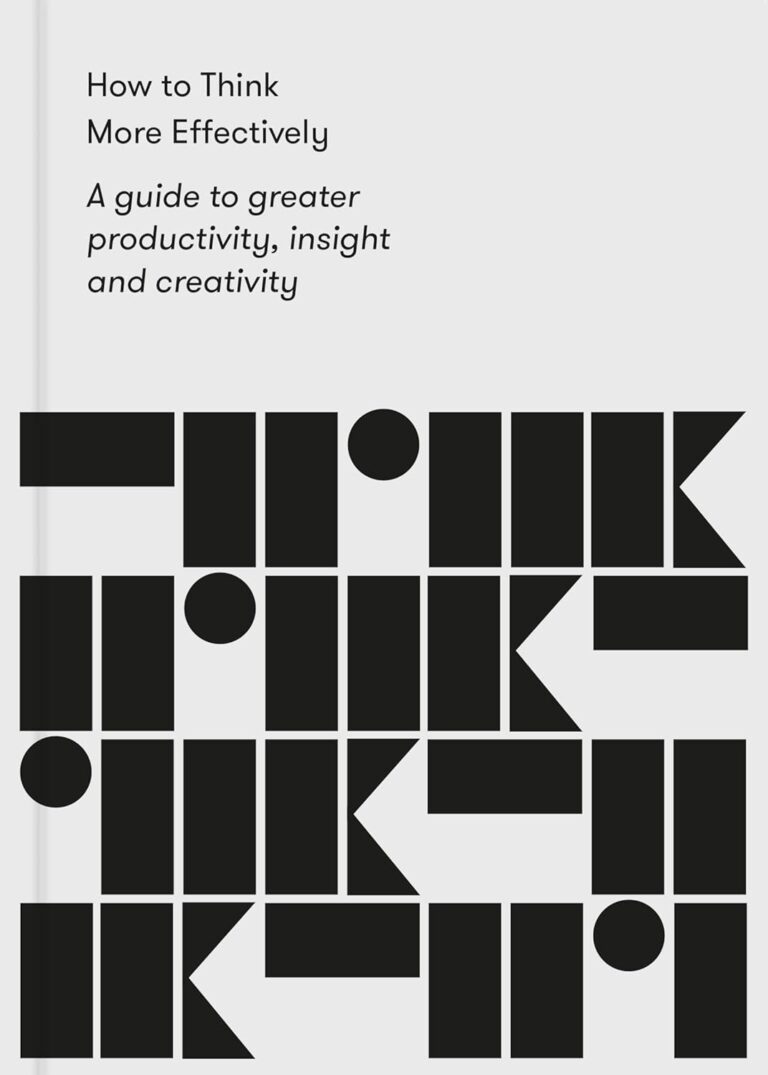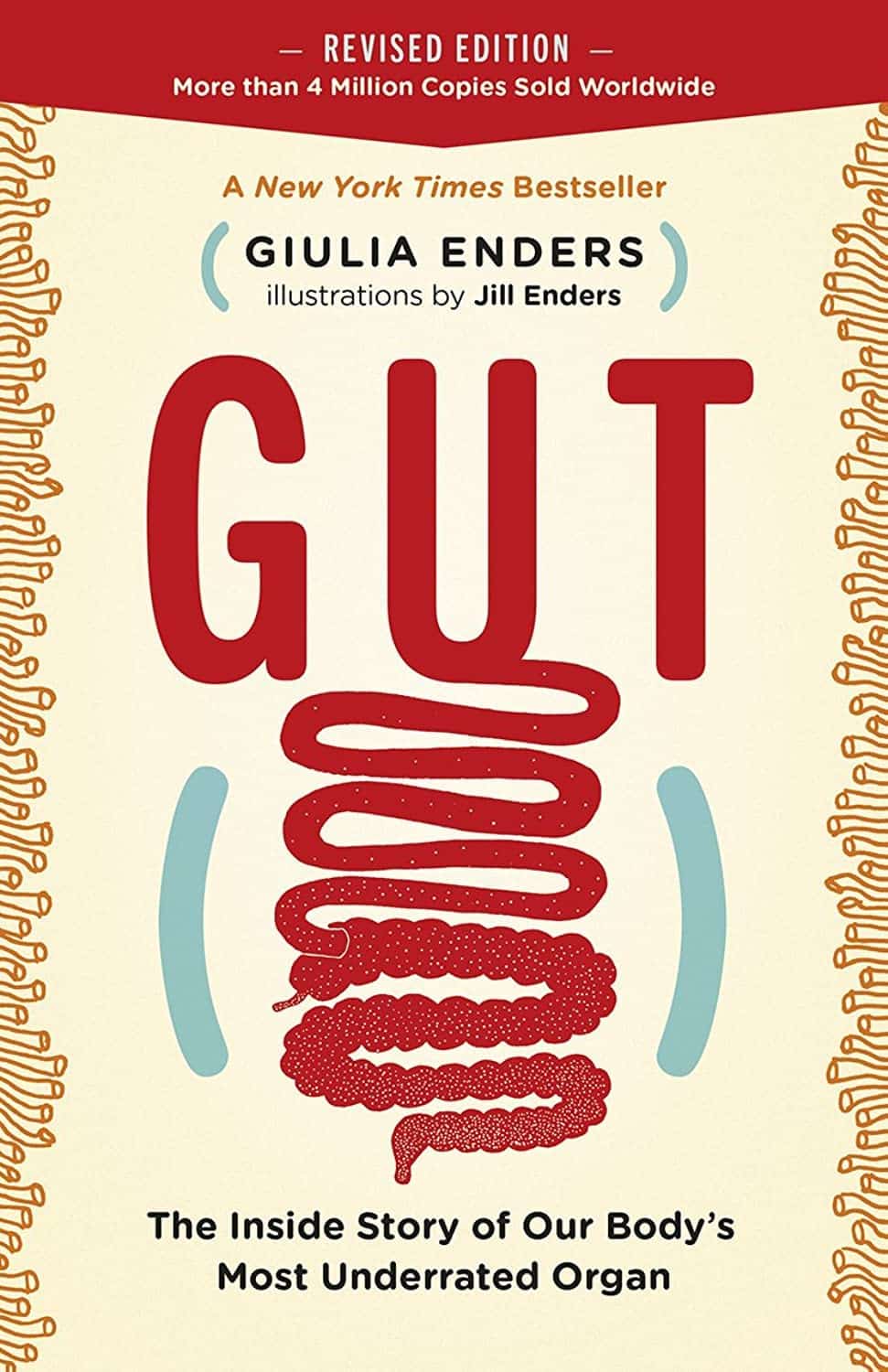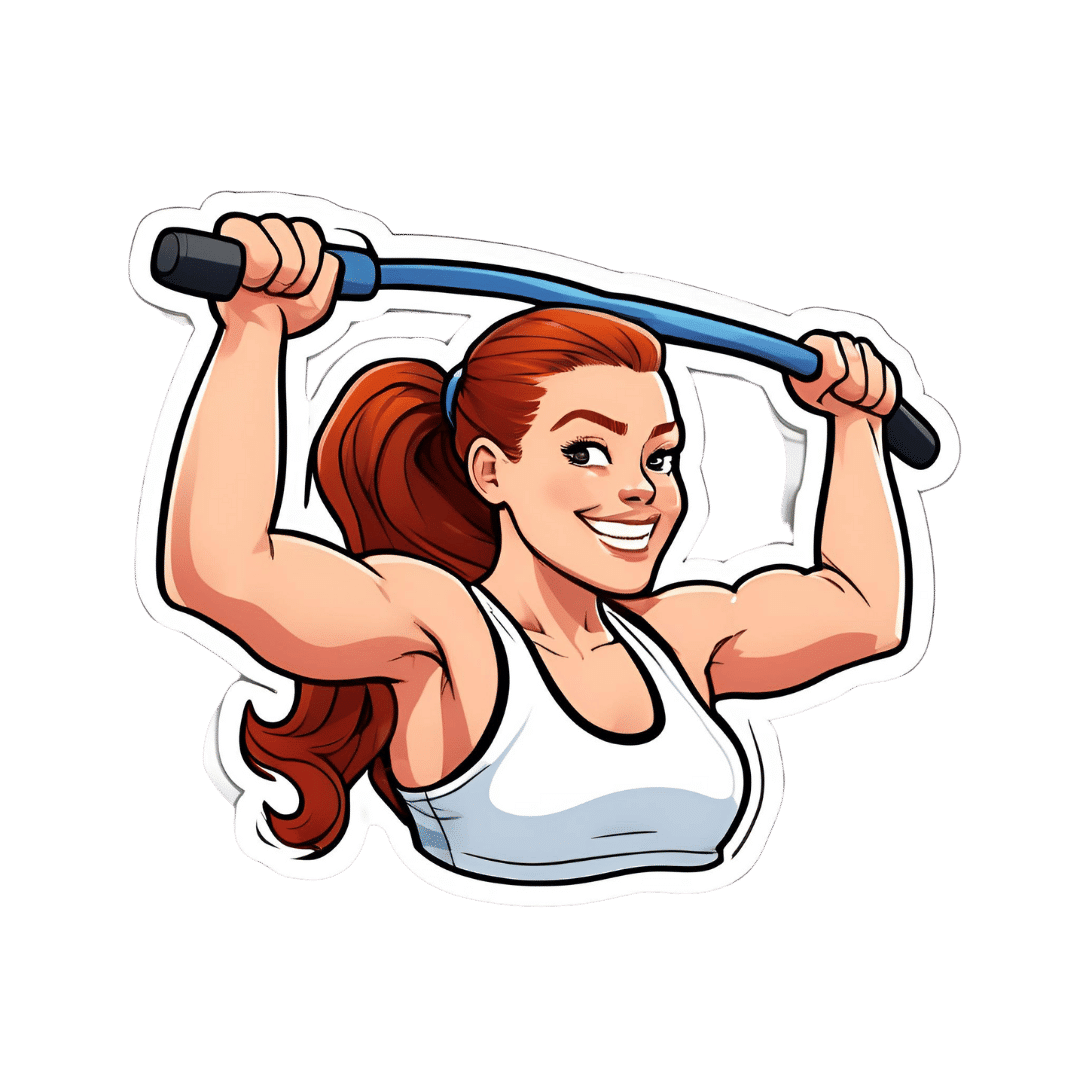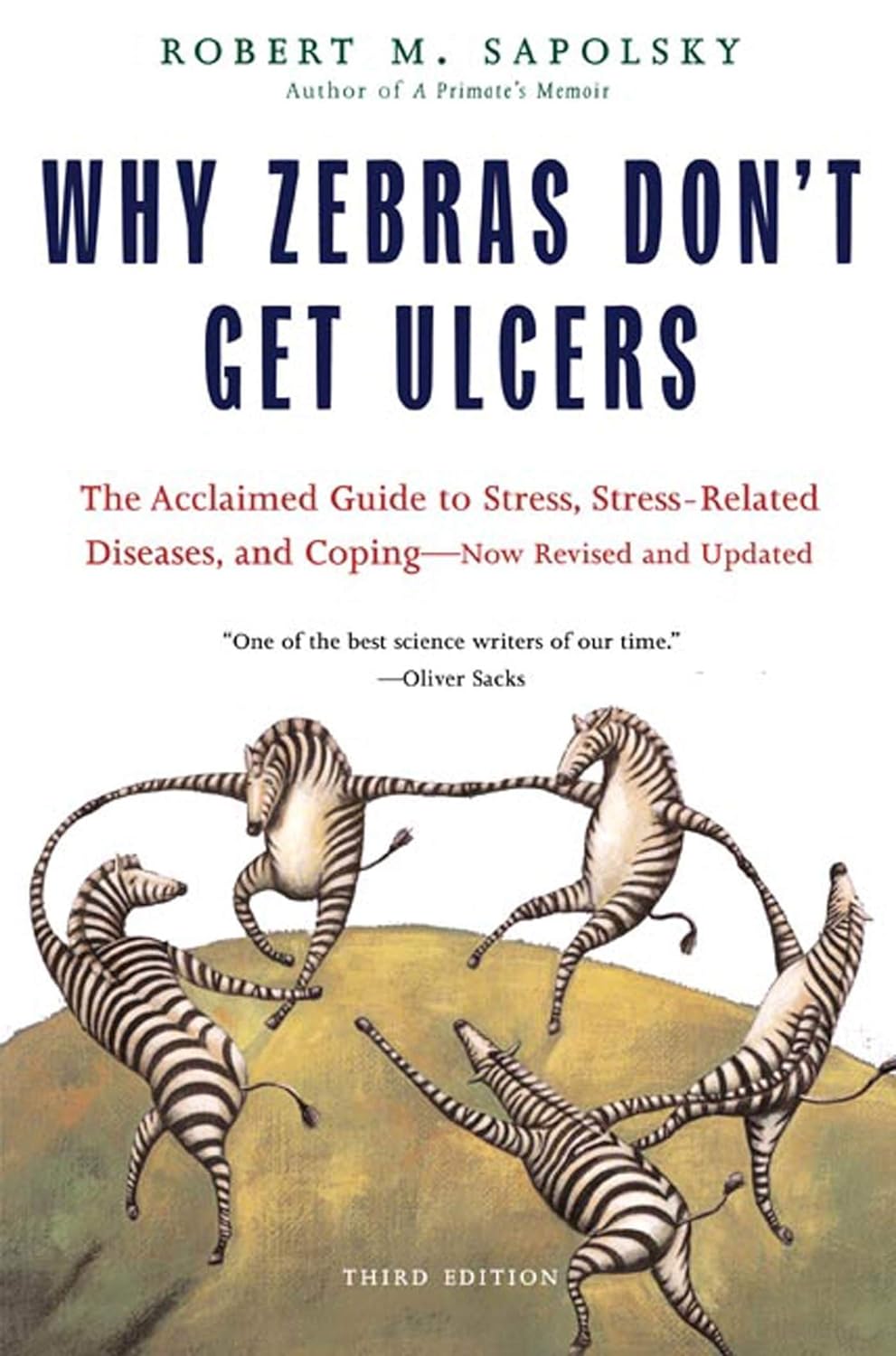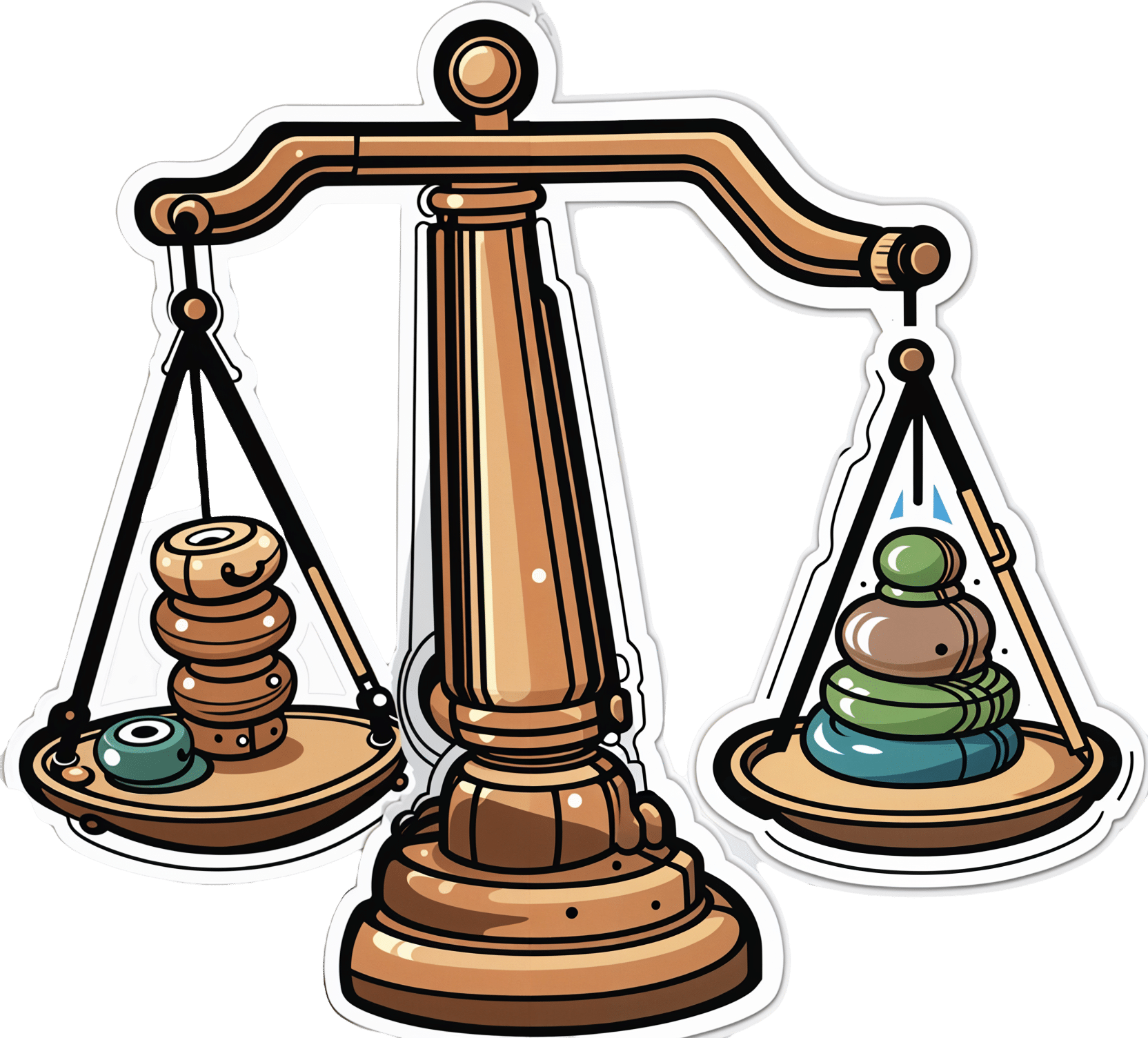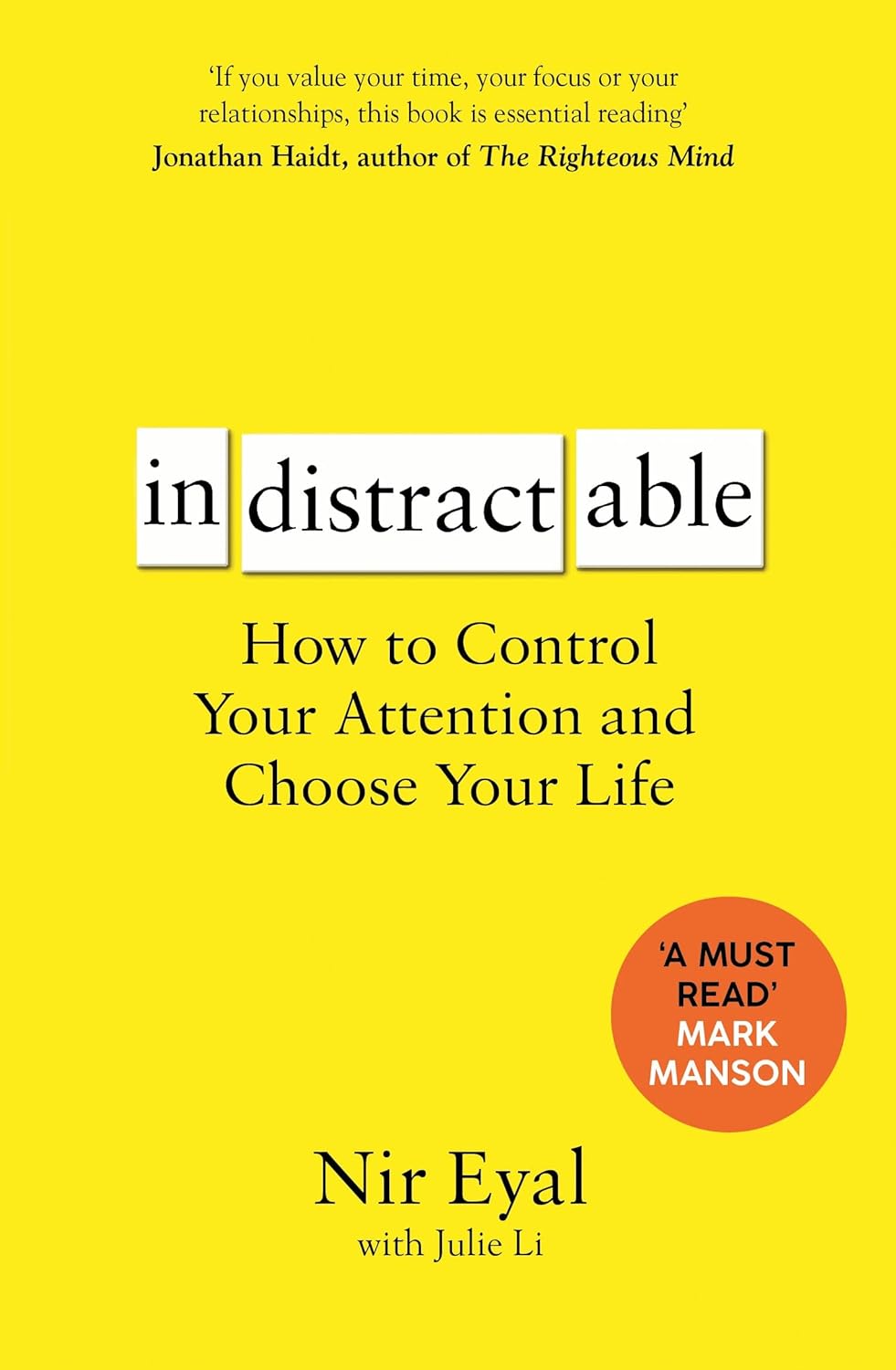
Indistractable – by Nir Eyal
10almonds is reader-supported. We may, at no cost to you, receive a portion of sales if you purchase a product through a link in this article.
Have you ever felt that you could accomplish anything you wanted/needed, if only you didn’t get distracted?
This book lays out a series of psychological interventions for precisely that aim, and it goes a lot beyond the usual “download/delete these apps to help you stop checking social media every 47 seconds”.
Some you’ll have heard of before, some you won’t have, and if even one method works for you, it’ll have been well worth your while reading this book. This reviewer, for example, enjoyed the call to identity-based strength, e.g. adopting an “I am indistractable*” perspective going into tasks. This is akin to the strength of, for example, “I don’t drink” over “I am a recovering alcoholic”.
*the usual spelling of this, by the way, is “undistractable”, but we use the author’s version here for consistency. It’s a great marketing gimmick, as all searches for the word “indistractable” will bring up his book.
Nor is the book just about maximizing productivity to the detriment of everything else; this is not about having a 25 hours per day “grindset”. Rather, it even makes sure to cover such things as focusing on one’s loved ones, for instance.
Bottom line: if you’ve tried blocking out the distractions but still find you can’t focus, this book offers next-level solutions
Click here to check out Indistractible, and become indeed indistractable!
Don’t Forget…
Did you arrive here from our newsletter? Don’t forget to return to the email to continue learning!
Recommended
Learn to Age Gracefully
Join the 98k+ American women taking control of their health & aging with our 100% free (and fun!) daily emails:
-
Gut – by Dr. Giulia Enders
10almonds is reader-supported. We may, at no cost to you, receive a portion of sales if you purchase a product through a link in this article.
On account of being an organ (or rather, a system of organs) whose functions are almost entirely autonomic, most of us don’t think about our gut much. We usually know there’s acid in the stomach, and we usually know there are “good and bad” gut bacteria. But what of the rest of what goes on?
For anyone who has a hazy half-remembered knowledge from school, this will serve as not only a reminder, but a distinct upgrade in knowledge.
Dr. Giuliua Enders talks us through not just the processes of what goes on, but, as a medical doctor, also many instances of what can go wrong, for example:
- Why do some people’s bodies mistake nuts for a deadly threat (and consequently, accidentally elevate them to the status of actually becoming a deadly threat)?
- Why are some people lactose-intolerant, and why do food intolerances often pop up later with age?
- Why do constipation and diarrhoea happen?
- Why is it that stress can cause stomach ulcers?
The style of writing is light and easy-reading, and the illustrations are clear too. This is a very accessible book that doesn’t assume prior knowledge, and also doesn’t skimp on the scientific explanations—there’s no dumbing down here.
Bottom line: knowing what goes on in our gut as akin to knowing what goes on under the hood of a car. A lot of the time we don’t need to know, but knowing can make a big difference from time to time, and that’s when you’ll wish you’d learned!
Share This Post
-
How To Get Your First Pull-Up
10almonds is reader-supported. We may, at no cost to you, receive a portion of sales if you purchase a product through a link in this article.
Pull-ups are a great compound exercise that works most of the upper body. However, it can be frustrating for many, if unable to do more than dangle and struggle while not going anywhere. That’s not actually bad, by the way! Of course it’s not great athletic performance, but in terms of exercise, “dangling and struggling while not going anywhere” is an isometric exercise that has plenty of benefits of its own. However, for those who would rather go up in the world, personal trainer Meg Gallagher shows the way:
The Only Way Is Up?
Gallagher offers a few methods; the first is simply an improvement on the “dangling and struggling while not going anywhere” method, but doing it with good form. It’s called the…
Hollow body hold:
- Hang from the bar with legs and feet together.
- Maintain a posterior pelvic tilt (i.e. don’t let your hips roll forwards, and don’t let your butt stick out more than is necessary by mere virtue of having a butt)
- Engage your core by shortening the space between your ribs and pelvis.
- Turn on your abs and lats, with your head slightly behind the bar.
- Practice the hollow body hang instead of dead hangs to build grip and core strength.
Another method is now moving on from the hollow body hold, and shows that in fact, up is not the only way. It’s called…
Negative pull-ups:
- Jump up to get your chin over the bar, then slowly lower yourself in a controlled manner.
- Prioritize negative pull-ups over other exercises to build strength.
- You can use modifications like resistance bands or feet assistance if necessary to extend the duration of your negative pull-up, but these are “crutches”, so try to move on from them as soon as you reasonably can—same if your gym has an “assisted pull-up” machine, consisting of a moving platform with a variable counterweight, mimicking how a pull-up would feel if your body were lighter.
- Practice resisting throughout the entire range of motion.
To give a sense of direction, Gallagher offers the following program:
- On day 1, test how long you can resist the negative pull-up (e.g., 10 seconds).
- For each session, multiply your time by 2 (e.g., 10 seconds × 2 = 20 seconds total).
- Break the total volume into as many sets as needed (e.g., 2 sets of 10 seconds or 4 sets of 5 seconds).
- After each session, add 2 seconds to the total volume for the next session.
- Aim for 3 sessions per week for 3–4 weeks, increasing by 2 seconds each session.
- When you reach about 25 seconds, you should be close to performing your first pull-up.
For more on all of this, plus a few other things to try, plus visual demonstrations, enjoy:
Click Here If The Embedded Video Doesn’t Load Automatically!
Want to learn more?
You might also like to read:
Take care!
Share This Post
-
What you need to know about PCOS
10almonds is reader-supported. We may, at no cost to you, receive a portion of sales if you purchase a product through a link in this article.
In 2008, microbiologist Sasha Ottey saw her OB-GYN because she had missed some periods. The doctor ran blood tests and gave her an ultrasound, diagnosing her with polycystic ovary syndrome (PCOS). She also told her not to worry, referred her to an endocrinologist (a doctor who specializes in hormones), and told her to come back when she wanted to get pregnant.
“I found [that] quite dismissive because that was my reason for presenting to her,” Ottey tells PGN. “I felt that she was missing an opportunity to educate me on PCOS, and that was just not an accurate message: Missing periods can lead to other serious, life-threatening health conditions.”
During the consultation with the endocrinologist, Ottey was told to lose weight and come back in six months. “Again, I felt dismissed and left up to my own devices to understand this condition and how to manage it,” she says.
Following that experience, Ottey began researching and found that thousands of people around the world had similar experiences with their PCOS diagnoses, which led her to start and lead the advocacy and support organization PCOS Challenge.
PCOS is the most common hormonal condition affecting people with ovaries of reproductive age. In the United States, one in 10 women of childbearing age have the condition, which affects the endocrine and reproductive systems and is a common cause of infertility. Yet, the condition is significantly underdiagnosed—especially among people of color—and under-researched.
Read on to find out more about PCOS, what symptoms to look out for, what treatments are available, and useful resources.
What is PCOS, and what are its most common symptoms?
PCOS is a chronic hormonal condition that affects how the ovaries work. A hormonal imbalance causes people with PCOS to have too much testosterone, the male sex hormone, which can make their periods irregular and cause hirsutism (extra hair), explains Dr. Melanie Cree, associate professor at the University of Colorado School of Medicine and director of the Multi-Disciplinary PCOS clinic at Children’s Hospital Colorado.
This means that people can have excess facial or body hair or experience hair loss.
PCOS also impacts the relationship between insulin—the hormone released when we eat—and testosterone.
“In women with PCOS, it seems like their ovaries are sensitive to insulin, and so when their ovaries see insulin, [they] make extra testosterone,” Cree adds. “So things that affect insulin levels [like sugary drinks] can affect testosterone levels.”
Other common symptoms associated with PCOS include:
- Acne
- Thinning hair
- Skin tags or excess skin in the armpits or neck
- Ovaries with many cysts
- Infertility
- Anxiety, depression, and other mental health conditions
- Sleep apnea, a condition where breathing stops and restarts while sleeping
What causes PCOS?
The cause is still unknown, but researchers have found that the condition is genetic and can be inherited. Experts have found that exposure to harmful chemicals like PFAs, which can be present in drinking water, and BPA, commonly used in plastics, can also increase the risk for PCOS.
Studies have shown that “BPA can change how the endocrine system develops in a developing fetus … and that women with PCOS tend to also have more BPA in their bodies,” adds Dr. Felice Gersh, an OB-GYN and founder and director of the Integrative Medical Group of Irvine, which treats patients with PCOS.
How is PCOS diagnosed?
PCOS is diagnosed through a physical exam; a conversation with your health care provider about your symptoms and medical history; a blood test to measure your hormone levels; and, in some cases, an ultrasound to see your ovaries.
PCOS is what’s known as a “diagnosis of exclusion,” Ottey says, meaning that the provider must rule out other conditions, such as thyroid disease, before diagnosing it.
Why isn’t more known about PCOS?
Research on PCOS has been scarce, underfunded, and narrowly focused. Research on the condition has largely focused on the reproductive system, Ottey says, even though it also affects many aspects of a person’s life, including their mental health, appearance, metabolism, and weight.
“There is the point of getting pregnant, and the struggle to get pregnant for so many people,” Ottey adds. “[And] once that happens, [the condition] also impacts your ability to carry a healthy pregnancy, to have healthy babies. But outside of that, your metabolic health is at risk from having PCOS, your mental health is at risk, [and] overall health and quality of life, they’re all impacted by PCOS.”
People with PCOS are more likely to develop other serious health issues, like high blood pressure, heart problems, high cholesterol, uterine cancer, and diabetes. Cree says that teenagers with PCOS and obesity have “an 18-fold higher risk of type 2 diabetes” in their teens and that teenagers who get type 2 diabetes are starting to die in their late 20s and early 30s.
What are some treatments for PCOS?
There is still no single medication approved by the Food and Drug Administration specifically for PCOS, though advocacy groups like PCOS Challenge are working with the agency to incorporate patient experiences and testimonials into a possible future treatment. Treatment depends on what symptoms you experience and what your main concerns are.
For now, treatment options include the following:
- Birth control: Your provider may prescribe birth control pills to lower testosterone levels and regulate your menstrual cycle.
- Lifestyle changes: Because testosterone can affect insulin levels, Cree explains that regardless of a patient’s weight, a diet with lower simple carbohydrates (such as candy, sugar, sweets, juices, sodas, and coffee drinks) is recommended.
“When you have a large amount of sugar like that, especially as a liquid, it gets into your bloodstream very quickly,” adds Cree. “And so you then release a ton of insulin that goes to the ovary, and you make a bunch of testosterone.”
More exercise is also recommended for both weight loss and weight maintenance, Cree says: “Food changes and better activity work directly to lower insulin, to lower testosterone.”
- Metformin: Even though it’s a medication for type 2 diabetes, it’s used in patients with PCOS because it can reduce insulin levels, and as a result, lower testosterone levels.
What should I keep in mind if I have (or think I may have) PCOS?
If your periods are irregular or you have acne, facial hair, or hair loss, tell your provider—it could be a sign that you have PCOS or another condition. And ask questions.
“I call periods a vital sign for women, if you’re not taking hormones,” Cree says. “Our bodies are really smart: Periods are to get pregnant, and if our body senses that we’re not healthy enough to get pregnant, then we don’t have periods. That means we’ve got to figure out why.”
Once you’re diagnosed, Ottey recommends that you “don’t go through extremes, yo-yo dieting, or trying to achieve massive weight loss—it only rebounds.”
She adds that “when you get this diagnosis, [there’s] a lot that might feel like it’s being taken away from you: ‘Don’t do this. Don’t eat this. Don’t do that.’ But what I want everyone to think of is what brings you joy, and do more of that and incorporate a lot of healthy activities into your life.”
Resources for PCOS patients:
- AskPCOS: A guide designed by experts on the condition that helps answer all your questions about it and how to manage it.
- PCOS Challenge: An advocacy and support organization for people with PCOS.
- PCOS Patient Communication Guide: A tool for better communication with your health care providers.
- Polycystic Ovary Syndrome Question Prompt List: Questions you can ask your provider about PCOS.
For more information, talk to your health care provider.
This article first appeared on Public Good News and is republished here under a Creative Commons license.
Share This Post
Related Posts
-
Why Zebras Don’t Get Ulcers – by Dr. Robert M. Sapolsky
10almonds is reader-supported. We may, at no cost to you, receive a portion of sales if you purchase a product through a link in this article.
The book does kick off with a section that didn’t age well—he talks of the stress induced globally by the Spanish Flu pandemic of 1918, and how that kind of thing just doesn’t happen any more. Today, we have much less existentially dangerous stressors!
However, the fact we went and had another pandemic really only adds weight to the general arguments of the book, rather than detracting.
We are consistently beset by “the slings and arrows of outrageous fortune” as Shakespeare would put it, and there’s a reason (or twenty) why many people go grocery-shopping with the cortisol levels of someone being hunted for sport.
So, why don’t zebras get ulcers, as they actually are hunted for food?
They don’t have rent to pay or a mortgage, they don’t have taxes, or traffic, or a broken washing machine, or a project due in the morning. Their problems come one at a time. They have a useful stress response to a stressful situation (say, being chased by lions), and when the danger is over, they go back to grazing. They have time to recover.
For us, we are (usually) not being chased by lions. But we have everything else, constantly, around the clock. So, how to fix that?
Dr. Sapolsky comprehensively describes our physiological responses to stress in quite different terms than many. By reframing stress responses as part of the homeostatic system—trying to get the body back into balance—we find a solution, or rather: ways to help our bodies recover.
The style is “pop-science” and is very accessible for the lay reader while still clearly coming from a top-level academic who is neck-deep in neuroendocrinological research. Best of both worlds!
Bottom line: if you try to take very day at a time, but sometimes several days gang up on you at once, and you’d like to learn more about what happens inside you as a result and how to fix that, this book is for you!
Click here to check out “Why Zebras Don’t Get Ulcers” and give yourself a break!
Don’t Forget…
Did you arrive here from our newsletter? Don’t forget to return to the email to continue learning!
Learn to Age Gracefully
Join the 98k+ American women taking control of their health & aging with our 100% free (and fun!) daily emails:
-
I’ve been diagnosed with cancer. How do I tell my children?
10almonds is reader-supported. We may, at no cost to you, receive a portion of sales if you purchase a product through a link in this article.
With around one in 50 adults diagnosed with cancer each year, many people are faced with the difficult task of sharing the news of their diagnosis with their loved ones. Parents with cancer may be most worried about telling their children.
It’s best to give children factual and age-appropriate information, so children don’t create their own explanations or blame themselves. Over time, supportive family relationships and open communication help children adjust to their parent’s diagnosis and treatment.
It’s natural to feel you don’t have the skills or knowledge to talk with your children about cancer. But preparing for the conversation can improve your confidence.
Benjamin Manley/Unsplash Preparing for the conversation
Choose a suitable time and location in a place where your children feel comfortable. Turn off distractions such as screens and phones.
For teenagers, who can find face-to-face conversations confronting, think about talking while you are going for a walk.
Consider if you will tell all children at once or separately. Will you be the only adult present, or will having another adult close to your child be helpful? Another adult might give your children a person they can talk to later, especially to answer questions they might be worried about asking you.
Choose the time and location when your children feel comfortable. Craig Adderley/Pexels Finally, plan what to do after the conversation, like doing an activity with them that they enjoy. Older children and teenagers might want some time alone to digest the news, but you can suggest things you know they like to do to relax.
Also consider what you might need to support yourself.
Preparing the words
Parents might be worried about the best words or language to use to make sure the explanations are at a level their child understands. Make a plan for what you will say and take notes to stay on track.
The toughest part is likely to be saying to your children that you have cancer. It can help to practise saying those words out aloud.
Ask family and friends for their feedback on what you want to say. Make use of guides by the Cancer Council, which provide age-appropriate wording for explaining medical terms like “cancer”, “chemotherapy” and “tumour”.
Having the conversation
Being open, honest and factual is important. Consider the balance between being too vague, and providing too much information. The amount and type of information you give will be based on their age and previous experiences with illness.
Remember, if things don’t go as planned, you can always try again later.
Start by telling your children the news in a few short sentences, describing what you know about the diagnosis in language suitable for their age. Generally, this information will include the name of the cancer, the area of the body affected and what will be involved in treatment.
Let them know what to expect in the coming weeks and months. Balance hope with reality. For example:
The doctors will do everything they can to help me get well. But, it is going to be a long road and the treatments will make me quite sick.
Check what your child knows about cancer. Young children may not know much about cancer, while primary school-aged children are starting to understand that it is a serious illness. Young children may worry about becoming unwell themselves, or other loved ones becoming sick.
Young children might worry about other loved ones becoming sick. Pixabay/Pexels Older children and teenagers may have experiences with cancer through other family members, friends at school or social media.
This process allows you to correct any misconceptions and provides opportunities for them to ask questions. Regardless of their level of knowledge, it is important to reassure them that the cancer is not their fault.
Ask them if there is anything they want to know or say. Talk to them about what will stay the same as well as what may change. For example:
You can still do gymnastics, but sometimes Kate’s mum will have to pick you up if I am having treatment.
If you can’t answer their questions, be OK with saying “I’m not sure”, or “I will try to find out”.
Finally, tell children you love them and offer them comfort.
How might they respond?
Be prepared for a range of different responses. Some might be distressed and cry, others might be angry, and some might not seem upset at all. This might be due to shock, or a sign they need time to process the news. It also might mean they are trying to be brave because they don’t want to upset you.
Children’s reactions will change over time as they come to terms with the news and process the information. They might seem like they are happy and coping well, then be teary and clingy, or angry and irritable.
Older children and teenagers may ask if they can tell their friends and family about what is happening. It may be useful to come together as a family to discuss how to inform friends and family.
What’s next?
Consider the conversation the first of many ongoing discussions. Let children know they can talk to you and ask questions.
Resources might also help; for example, The Cancer Council’s app for children and teenagers and Redkite’s library of free books for families affected by cancer.
If you or other adults involved in the children’s lives are concerned about how they are coping, speak to your GP or treating specialist about options for psychological support.
Cassy Dittman, Senior Lecturer/Head of Course (Undergraduate Psychology), Research Fellow, Manna Institute, CQUniversity Australia; Govind Krishnamoorthy, Senior Lecturer, School of Psychology and Wellbeing, Post Doctoral Fellow, Manna Institute, University of Southern Queensland, and Marg Rogers, Senior Lecturer, Early Childhood Education; Post Doctoral Fellow, Manna Institute, University of New England
This article is republished from The Conversation under a Creative Commons license. Read the original article.
Don’t Forget…
Did you arrive here from our newsletter? Don’t forget to return to the email to continue learning!
Learn to Age Gracefully
Join the 98k+ American women taking control of their health & aging with our 100% free (and fun!) daily emails:
-
Decoding Hormone Balancing in Ads
10almonds is reader-supported. We may, at no cost to you, receive a portion of sales if you purchase a product through a link in this article.
It’s Q&A Time!
This is the bit whereby each week, we respond to subscriber questions/requests/etc
Have something you’d like to ask us, or ask us to look into? Hit reply to any of our emails, or use the feedback widget at the bottom, and a Real Human™ will be glad to read it!
Q: As to specific health topics, I would love to see someone address all these Instagram ads targeted to women that claim “You only need to ‘balance your hormones’ to lose weight, get ripped, etc.” What does this mean? Which hormones are they all talking about? They all seem to be selling a workout program and/or supplements or something similar, as they are ads, after all. Is there any science behind this stuff or is it mostly hot air, as I suspect?
Thank you for asking this, as your question prompted yesterday’s main feature, What Does “Balancing Your Hormones” Even Mean?
That’s a great suggestion also about addressing ads (and goes for health-related things in general, not just hormonal stuff) and examining their claims, what they mean, how they work (if they work!), and what’s “technically true but may
be misleading* cause confusion”*We don’t want companies to sue us, of course.
Only, we’re going to need your help for this one, subscribers!
See, here at 10almonds we practice what we preach. We limit screen time, we focus on our work when working, and simply put, we don’t see as many ads as our thousands of subscribers do. Also, ads tend to be targeted to the individual, and often vary from country to country, so chances are good that we’re not seeing the same ads that you’re seeing.
So, how about we pull together as a bit of a 10almonds community project?
- Step 1: add our email address to your contacts list, if you haven’t already
- Step 2: When you see an ad you’re curious about, select “share” (there is usually an option to share ads, but if not, feel free to screenshot or such)
- Step 3: Send the ad to us by email
We’ll do the rest! Whenever we have enough ads to review, we’ll do a special on the topic.
We will categorically not be able to do this without you, so please do join in—Many thanks in advance!
Don’t Forget…
Did you arrive here from our newsletter? Don’t forget to return to the email to continue learning!
Learn to Age Gracefully
Join the 98k+ American women taking control of their health & aging with our 100% free (and fun!) daily emails:

